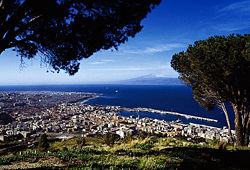Reggio Calabria
| Reggio Calabria | |||
 |
|||
|
|||
 |
|||
| Coordinates: | |||
| Region | Calabria | ||
|---|---|---|---|
| Province | Province of Reggio Calabria | ||
| Founded | 720 BC[1] | ||
| Government | |||
| - Mayor | Giuseppe Scopelliti | ||
| Area | |||
| - Total | 236 km² (91.1 sq mi) | ||
| Population (January 2006) | |||
| - Total | 184,504 (18th) | ||
| - Density | 782/km² (2,025/sq mi) | ||
| Time zone | CET (UTC+1) | ||
| Postal codes | 89100 | ||
| Area code(s) | 0965 | ||
| Patron saints | Saint George | ||
| Website: http://www.reggiocal.it | |||
Reggio di Calabria (Italian pronunciation: /ˈrɛʤ:o ˌdikaˈlabrja/; Calabrian dialect: Rìggiu, Greek-Calabrian: Righi, Greek: Ῥήγιον- Rhegion), commonly known as Reggio Calabria or Reggio. A historic city in southern Italy, the capital of the Province of Reggio Calabria as well as the largest and oldest city in the Calabria region. The city is over 2,700 years old and was previously the capital city of Calabria, until it was moved to Catanzaro, though the headquarters of the Calabrian Regional Council remains.
Founded by the Ancient Greeks as Rhegion, meaning it breaks away, it was a well established settlement of Magna Graecia, later becoming part of the Roman Republic and Byzantine Empire. Reggio emerged as the capital of the Duchy of Calabria for a period until it was incorporated into the Kingdom of Sicily. It was then part of the Kingdom of Naples, later known as Two Sicilies, from 1282 to 1860, until the Italian unification.
Located on the toe of the Italian peninsula boot, Reggio retains a somewhat rural feel despite its sizable population. There are approximately 180,000 people within the city and the local population are known as Reggians. Industry in the city revolves primarily around agriculture and the exportation of fruits and tobacco, also as Reggio is a port city, it has a fishing industry. The beaches of the city have helped make it a popular tourist destination.[2] The municipality of Reggio Calabria contains the frazioni (subdivisions, mainly villages and hamlets) Catona, Gallico, Archi, Pentimele, Gallina, Mosorrofa (Greek: Messorofè), Ortì (Greek: Orthioi), Pellaro (Greek: Pèllaros), Saracinello.
Contents |
Geography
Reggio di Calabria is located on the toe of the Italy boot, across from the island of Sicily. It is situated at the base of the Aspromonte, the long, craggy mountain range that runs up through the center of the region. The area has been subjected to several earthquakes and tsunami waves, over the centuries.
History
Founded as Rhegion by Greek settlers in 720 BC[3] the city was devastated by several major earthquakes and associated tsunami. During the Roman Empire it was called Rhegium Julium as a noble Roman city. Later Reggio di Calabria became a Byzantine city, and in the 12th century, it became part of the Kingdom of Sicily, and then in the 13th century, it became part of the Kingdom of Naples.
Reggio Calabria is known as the location of the first dated Hebrew book, a Rashi commentary on the Pentateuch, printed in 1475; [4] however, scholars consider Rome as the city where Hebrew printing began.
For Reggio di Calabria, the worst earthquakes came in 1783 and on 28 December 1908. The latter quake was the most devastating. Some 80 percent of all buildings in Reggio collapsed and many thousands were killed. Damage was even worse in Messina across the straits. That quake remains the worst on record in modern western European history. It took Reggio a generation to fully recover.
Main sights
- The National Museum of Greater Greece, housing the two famous Bronzi di Riace statues.
- The Cathedral, the largest religious building in Calabria.
- The Aragonese Castle, built before 540. It is now home to art exhibitions.
- Chiesa degli Ottimati ("Church of the Optimates"), in Byzantine-Norman style.
- The walls of the ancient city, one of the few remaining examples of the original Greek walls. They are divided into four separate sections, the one one the Falcomatà Seaside dating to the 4th century BC and attributed to the city's reconstruction by Dionysius II of Syracuse.
- Villa Zerbi, a villa in 14th-century Venetian style. It is the seat of exhibition of the Venice Biennale in southern Italy.
- Remains of Roman baths.
- The Town Art Gallery (Pinacoteca Comunale) housing works by Antonello da Messina (Abraham Served by the Angels and St. Jerome in Penitence), Mattia Preti, Luca Giordano, Giuseppe Benessai and others.
- The church of Saint Gaetano Catanoso (1879-1963) on via Catanoso in the Santo Spirito neighborhood. Canonized by Pope Benedict XVI on 23 October 2005, St. Gaetano is the first saint from Calabria since St.Francis of Paola, who was canonized in 1507. St Gaetano was founder of the Sisters of St. Veronica of the Holy Face. His glass tomb, a magnet for miracle seekers, is in the sanctuary. Museum exhibits as well. He was beatified by Pope John Paul II on 4 May 1997.

Noted Reggians
- For more information, see People from Reggio Calabria
|
|
See also
- University of Reggio Calabria
- List of mayors of Reggio Calabria
- Reggio Calabria Airport
- Roman Catholic Archdiocese of Reggio Calabria-Bova
- Saint Francis of Paola
References
- ↑ Foulke, Robert. The Sea Voyage Narrative. Routledge. ISBN 0415938945. http://books.google.com/books?id=cwpdkrGMS38C&pg=PA45&lpg=PA45&dq=%22reggio+calabria+founded+by+chalcis+and+messenia+ca+720+bc%22&source=web&ots=odjWOYr1A0&sig=aPQjWmBlQKDqnza9D0iB5k4aIPA&hl=en.
- ↑ "Reggio di Calabria", Questia.com (8 January 2008).
- ↑ Foulke, Robert. The Sea Voyage Narrative. Routledge. ISBN 0415938945. http://books.google.com/books?id=cwpdkrGMS38C&pg=PA45&lpg=PA45&dq=%22reggio+calabria+founded+by+chalcis+and+messenia+ca+720+bc%22&source=web&ots=odjWOYr1A0&sig=aPQjWmBlQKDqnza9D0iB5k4aIPA&hl=en.
- ↑ "The Books of the People of the Book - Hebraic Collections" (Hebrew book with date), Library of Congress, Washington, D.C., 2003-11-06, webpage: LibraryCongress-Hebraic.
External links
- Tourist Web Official Site of Reggio Calabria
- Official Web Site of Reggio Calabria
- The City of Reggio Calabria
- Province of Reggio Calabria
|
|||||||


